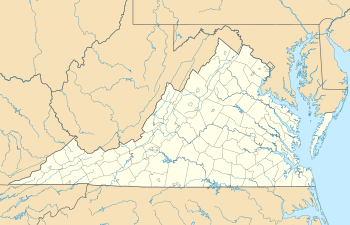Wilson Creek Bridge
This article includes a list of references, related reading, or external links, but its sources remain unclear because it lacks inline citations. (May 2009) |
Wilson Creek Bridge | |
|---|---|
 Wilson Creek Bridge, looking northeast | |
| Coordinates | 37°10′27″N 80°22′29″W / 37.17417°N 80.37472°W |
| Carries | Virginia Smart Road |
| Crosses | Wilson Creek, a tributary of the North Fork of the Roanoke River; County Route 723 (Ellett Road), part of U.S. Bicycle Route 76 and the TransAmerica Bicycle Trail |
| Locale | Montgomery County, Virginia |
| Maintained by | Virginia Tech Transportation Institute [1] |
| Characteristics | |
| Design | Cast-in-place cantilever box girder |
| Total length | 1,985 feet (605 m) |
| Width | 40 feet (12 m), 2 lanes |
| Longest span | 472 feet (144 m) |
| Clearance below | 175 feet (53 m) |
| History | |
| Opened | May 30, 2001 |
| Location | |
 | |
The Wilson Creek Bridge (also known as the Smart Road Bridge) is the tallest bridge in Virginia at 175 feet (53 m) tall, the second tallest being the Varina-Enon Bridge over the James River between Henrico County and Chesterfield County at 150 feet (46 m) tall.
The Wilson Creek Bridge is located in Montgomery County and was built as part of the Virginia Smart Road project. It is a cast-in-place cantilever box girder bridge and extends for 1,985 feet (605 m) with three spans of 472 feet (144 m) and two spans of 283 feet (86 m).
Construction
Construction began in August 1998. The bridge was designed by Florida-based Figg Engineering Group and built by PCL Civil Constructors Inc., a subsidiary of PCL Constructors Inc. at a cost of US$17.4 million. The bridge design is the same genre as the Natchez Trace Parkway Bridge. The bridge is composed of four double-tapered piers with stone inlay, two conventional abutments, and 100 cast-in-place segments. After review of the bridge design by the construction firm, the segments were changed from 4.5 m to 5 m segments, deleting 35 segments from the critical path of construction. The bridge was completed on May 30, 2001.
The cast-in-place structure consists of 9,647 cubic yards (7,376 m3) of concrete, 1,565,321 pounds (710,018 kg) of reinforcing steel, and 780,900 pounds (354,210 kg) of steel cables.
Awards
In 2002, the bridge received an honorable mention in the Federal Highway Administration's Excellence in Highway Design Awards, Category 3A: Major Highway Structures Over $10 Million. The bridge also received an award that year from the Concrete Reinforced Steel Institute, the only 2002 award-winner east of the Mississippi River.
Unique Features
The cast-in-place cantilever box girder bridge design is the only one of its kind in Virginia.
The bridge is hollow. Beneath the riding surface, the box girders are open with a width of 18 feet (5 m) and a height which varies from 12 feet (4 m) to 35 feet (11 m). Power and communication lines are carried in the hollow concrete box and run the length of the bridge. Manholes in the bridge deck allow researchers to enter the box to monitor testing equipment.
The support structure of the bridge is inlaid with Hokie Stone to blend in with the environment and meld with the architectural stylings of Virginia Tech.
Bridge Pictures
- Early construction
- During construction
- During construction
- Below main spans during construction
- Construction nearing completion
- Looking south
- Aerial looking southeast
- Looking east across Ellett Valley and Wilson Creek
- Looking northeast
- Looking northwest
References
- Brian Fortner, "High-Tech Highway", Civil Engineering, October, 1999
- Gunnar Lucko, "Means and Methods Analysis of a Cast-In-Place Balanced Cantilever Segmental Bridge: The Wilson Creek Bridge Case Study", Master's Thesis: Virginia Tech Department of Civil Engineering, November 30, 1999, accessed April 1, 2007
- "'Smart' Road Getting New Name: Willis", Roanoke Times, May 12, 2001
- Keith Harrison, "Wilson Creek Bridge Complete; Research Just Beginning", Marshall Concrete Products The Star, Fall/Winter 2001, Volume 2, Issue 2, accessed December 29, 2008
- American Segmental Bridge Institute (ASBI), "Smart Road Bridge, Near Blacksburg, VA, Receives CRSI Award", May 17, 2002, accessed April 1, 2007
- "Smart Road Bridge Wins Kudos", Roanoke Times, May 17, 2002
- "FHWA Gives Awards to Top Highway Designs", Federal Highway Administration, October 13, 2002
- "Design and Construction of Smart Road Over Wilson Creek: Montgomery County, Virginia", Transportation Research Board of the National Academies, 2002, accessed May 16, 2007
- Gunnar Lucko and Jesús M. de la Garza, "Constructability Considerations for Balanced Cantilever Construction", Practice Periodical on Structural Design and Construction, Volume 8, Issue 1, pp. 47–56, February, 2003, accessed July 20, 2007
- Virginia Department of Transportation (VDOT), "2003 success stories", accessed April 1, 2007
- American Association of State Highway and Transportation Officials - Subcommittee on Bridges and Structures, "Our Nation's Bridges: Virginia", June 2, 2005, accessed April 1, 2007
- VDOT - The Smart Road Bridge Over Wilson Creek, October 29, 2006, accessed April 1, 2007
- Greg Esposito, "Smart Road does bring benefits to valley", Roanoke Times, April 1, 2007
- Figg Engineering Group, accessed August 13, 2008
- PCL - construction details, accessed August 13, 2008
- AVAR - construction details on post-tensioning and form-travelers, accessed August 13, 2008
- Marshall Concrete Products - construction details on concrete for piers, superstructure, and bridge decks, accessed December 29, 2008
- NXL - inspection and engineering services, accessed August 13, 2008

